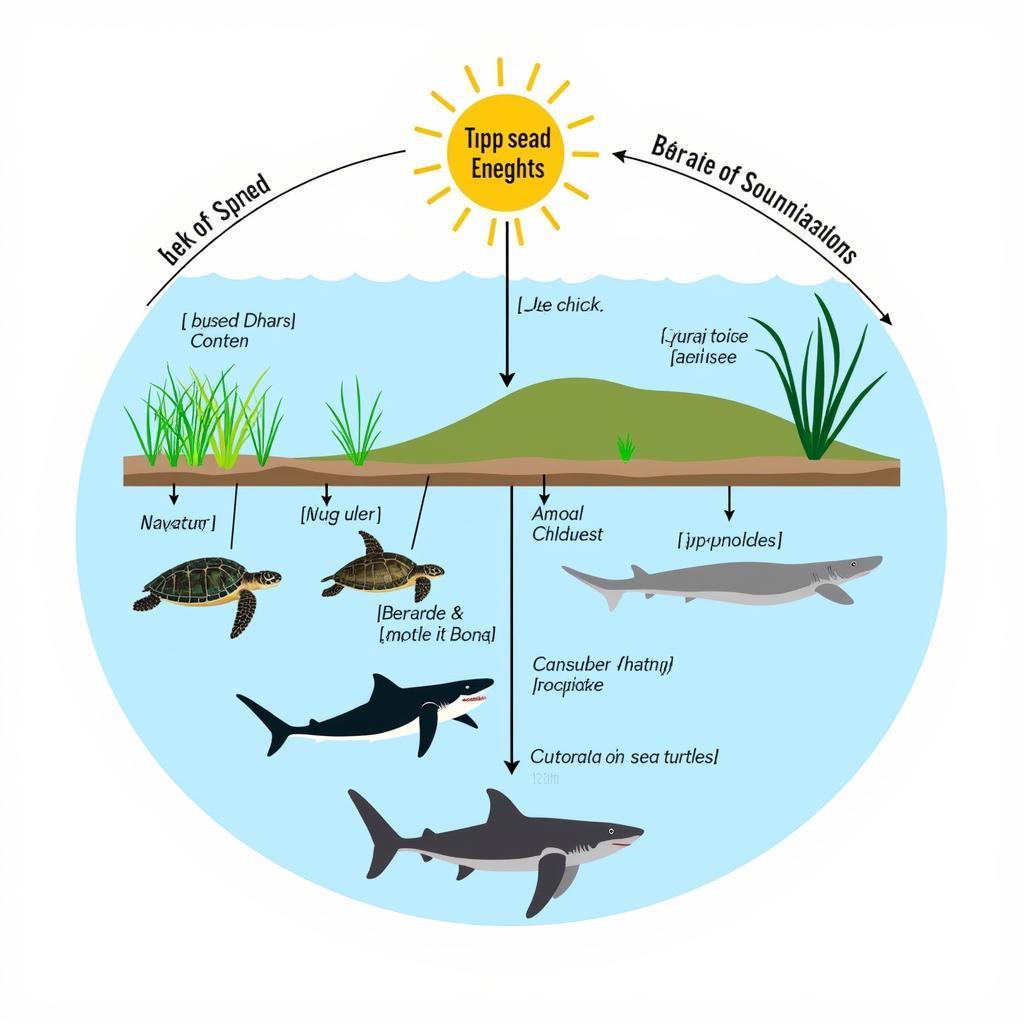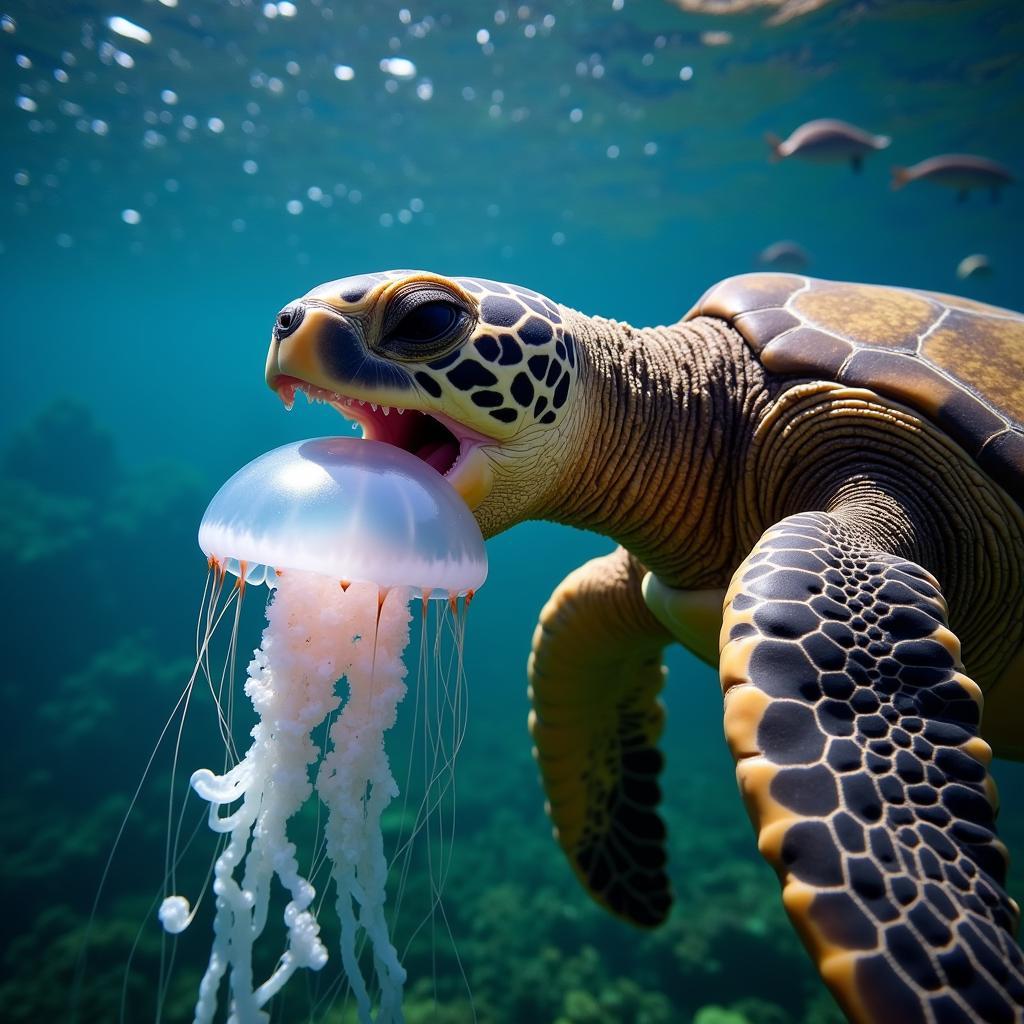The Food Chain Of Sea Turtles is a fascinating and complex web of life, crucial for the health of our oceans. These ancient mariners play a vital role in maintaining the balance of marine ecosystems, and understanding their dietary habits is key to their conservation. Let’s dive deep into the world of sea turtle diets and discover the intricate relationships that sustain them. After the introduction, we’ll explore the specifics of the food chain of sea turtles.
What Do Sea Turtles Eat?
Sea turtles, depending on their species, can be herbivores, carnivores, or omnivores. Green sea turtles, for example, are primarily herbivorous as adults, grazing on seagrass and algae. This grazing helps maintain healthy seagrass beds, which are vital habitats for many other marine species. Hawksbill turtles, on the other hand, have a specialized diet of sponges, using their beak-like mouths to access these often-toxic organisms. Loggerheads are omnivores, consuming a variety of invertebrates like crabs, jellyfish, and mollusks. Leatherback turtles primarily feed on jellyfish, playing a crucial role in regulating jellyfish populations.
The Sea Turtle Food Chain: A Delicate Balance
The food chain of a sea turtle encompasses various trophic levels, starting with the primary producers like phytoplankton and algae. These organisms form the base of the food web, providing energy for herbivorous sea turtles and other grazing animals. Carnivorous sea turtles then prey on these herbivores and smaller invertebrates, while larger predators like sharks and killer whales may prey on the sea turtles themselves. Understanding this delicate balance is crucial for conservation efforts. The food web of a sea turtle demonstrates this interconnectedness vividly.
 Sea Turtle Food Chain Diagram
Sea Turtle Food Chain Diagram
Threats to the Sea Turtle Food Chain
Human activities significantly impact the food chain of sea turtles. Pollution, particularly plastic debris, poses a serious threat. Sea turtles can mistake plastic bags for jellyfish, leading to ingestion and potentially fatal consequences. Habitat destruction, such as the loss of seagrass beds due to coastal development, also disrupts the food chain by reducing the availability of food sources. Climate change further exacerbates these issues by altering ocean temperatures and currents, impacting the distribution and abundance of prey species. It’s crucial that we address these threats to ensure the survival of these magnificent creatures. For information about necessary supplies for expeditions researching sea turtles, you can refer to the resources on survival gear and food.
How Can We Protect Sea Turtles and Their Food Chain?
Protecting sea turtles and their intricate food chain requires a multi-pronged approach. Reducing plastic pollution through individual actions and policy changes is essential. Supporting sustainable fishing practices and protecting critical habitats like seagrass beds are equally important. Raising awareness about the importance of sea turtle conservation and the interconnectedness of marine ecosystems can also empower individuals to make informed choices that benefit these animals.
 Sea Turtle Eating Jellyfish
Sea Turtle Eating Jellyfish
The Importance of Understanding the Food Chain of a Sea Turtle
Understanding the food chain of a sea turtle allows us to appreciate the vital role they play in marine ecosystems. Their feeding habits influence the health of seagrass beds, coral reefs, and jellyfish populations, impacting the overall biodiversity of the ocean. By protecting sea turtles and their food sources, we contribute to the health and resilience of our planet’s oceans. This information also helps us understand the effects of environmental changes on these creatures and implement effective conservation strategies.
Conclusion
The food chain of sea turtles is a complex and vital component of our oceans’ health. By understanding the intricacies of their diet and the threats they face, we can work together to protect these incredible creatures and ensure the long-term health of our planet. Let’s continue to explore, learn, and advocate for the conservation of sea turtles and their essential role in the marine ecosystem. The food chain of sea turtles is not just a biological concept; it’s a call to action for us all.
FAQ
- What is the main food source for green sea turtles? Seagrass and algae.
- What do hawksbill turtles primarily eat? Sponges.
- What kind of eaters are loggerhead sea turtles? Omnivores.
- What is the primary prey of leatherback turtles? Jellyfish.
- How does plastic pollution affect sea turtles? They can mistake it for food and ingest it.
- Why is understanding the sea turtle food chain important? It helps us understand their role in the ecosystem and how to protect them.
- What are some threats to the sea turtle food chain? Pollution, habitat destruction, and climate change.
Related Questions and Further Exploration
- What is the difference between a food chain and a food web?
- How do different species of sea turtles adapt to their specific diets?
- What are the long-term consequences of disrupting the sea turtle food chain?
- How can we support sustainable fishing practices to protect sea turtles?
You can find more information about bird food and its impact on the ecosystem at no grow bird food.
Need Support? Contact us 24/7:
Phone: 02437655121
Email: minacones@gmail.com
Address: 3PGH+8R9, ĐT70A, thôn Trung, Bắc Từ Liêm, Hà Nội, Việt Nam.